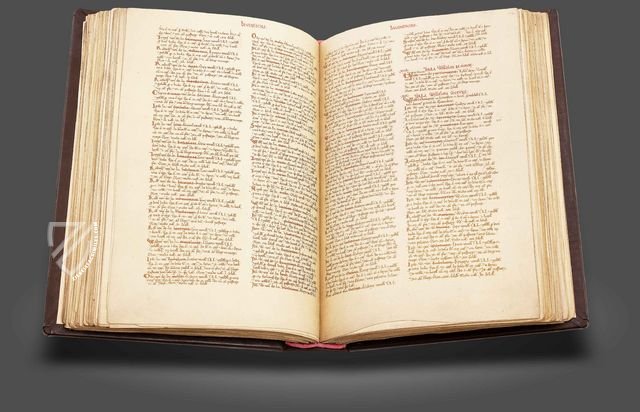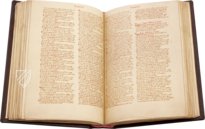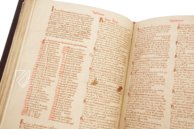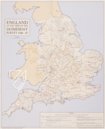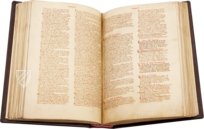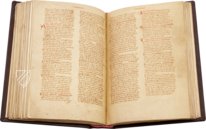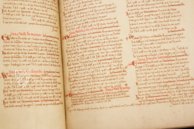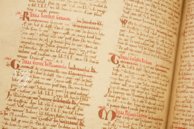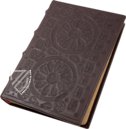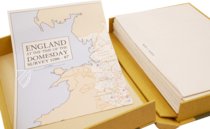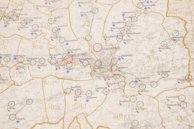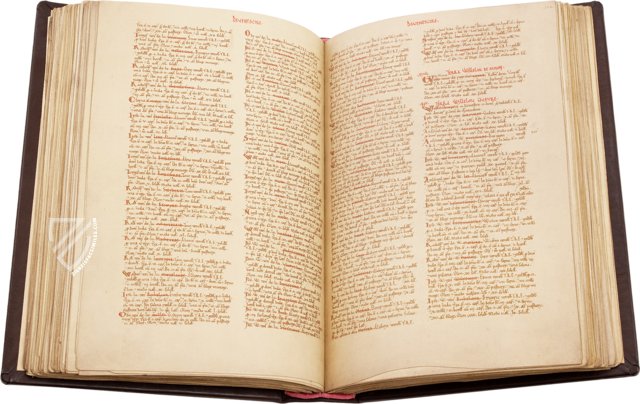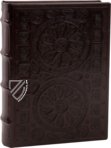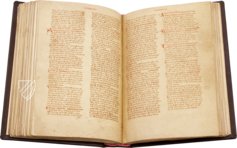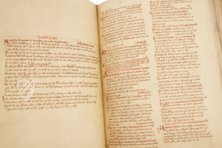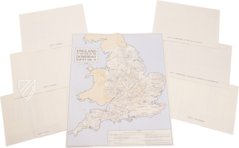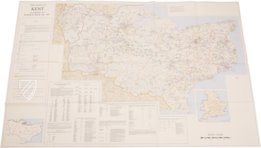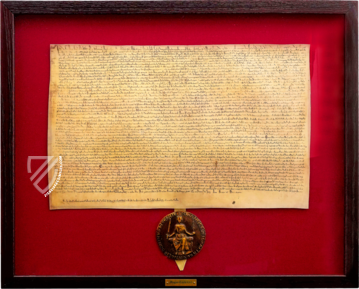Great Domesday Book
(3,000€ - 7,000€)
Twenty years after his legendary victory over the Kingdom of England at the Battle of Hastings in 1066, the new Norman ruler William the Conqueror (c. 1028-1087) ordered a remarkable census of his newly won realm that would not be surpassed in scope and detail until the late 19th century. The massive tome, known as the Great Domesday Book, was used by him and his successors to determine the taxes and duties owed to them. The name “Domesday” is an allusion to the Apocalypse, which was first mentioned in 1221. It indicates that the content of the book was perceived to be as final as the Last Judgement. The census of the population and their possessions along with the resulting manuscript were completed in 1086. The latter was an important basis for the Normans, on which they eventually established the richest and best organized kingdom of the European High Middle Ages.
Great Domesday Book
“Then, at the midwinter [1085], was the king in Gloucester with his council ... . After this had the king a large meeting, and very deep consultation with his council, about this land; how it was occupied, and by what sort of men. Then sent he his men over all England into each shire; commissioning them to find out ‘How many hundreds of hides were in the shire, what land the king himself had, and what stock upon the land; or, what dues he ought to have by the year from the shire’.”
Anglo-Saxon Chronicle
This famous tome was completed in 1086 at the behest of King William the Conqueror (ca. 1028-1087) in order to record the findings of the “Great Survey” described above. This was used by William and his successors to determine what taxes and other dues they could expect, and the extent of royal land holdings. It is written in Latin, with some vernacular where Latin equivalents did not exist. An invaluable source on medieval England for modern historians and economists, no other survey approaching the scope and extent of the Domesday Book was made in Britain for nearly 800 years until the 1873 Return of Owners of Land, referred to as the “Modern Domesday”.
A Working Document
Neatly written in black ink with red flourishes, corrections were made by crossing the words out with red ink and replacing them with text written in red. Most villages and towns in England are listed – 13,418 place names in total – save for those cities with tax exempt status, like London, areas in the North not yet under royal control, or territories where the local bishop had the exclusive right to taxation. It originally consisted to two volumes that were later combined: the “Little Domesday” covering much of Southern England, physically smaller but more detailed, and the “Great Domesday” covering the rest of England with less detail but more systematically.
As Final as Judgment Day
The name commonly applied to the manuscript first appeared in 1221 and is an allusion to the Last Judgement, i.e. doomsday or “domesday” according to contemporary English. This was, according to Richard FitzNeal (ca. 1130-98), royal treasurer to William the Conqueror’s grandson King Henry II (1133-89) because:
“The book is metaphorically called by the native English, Domesday, i.e., the Day of Judgement. For as the sentence of that strict and terrible last account cannot be evaded by any skillful subterfuge, so when this book is appealed to on those matters which it contains, its sentence cannot be quashed or set aside with impunity. That is why we have called the book "the Book of Judgement", ... not because it contains decisions on various difficult points, but because its decisions, like those of the Last Judgement, are unalterable.”
Codicology
- Alternative Titles
- Das große Buch vom Jüngsten Tag
Book of Winchester
King's Roll
Book of the Treasury
The Great Survey
Liber de Wintonia - Size / Format
- 826 pages / 36.7 × 25.8 cm
- Origin
- United Kingdom
- Date
- 1086–1087
- Epochs
- Style
- Language
- Script
- Protogothic
- Illustrations
- Red initials and rubrics
- Content
- Census and land survey of the year 1086
- Patron
- William the Conqueror
Great Domesday Book
Bosham
At the time of the survey, the royal estates in Sussex included two manors: one of which was the present-day village of Bosham. The short passage describes it as a very wealthy possession, including over 56 hides of land, a church, eight mills, two fisheries, and a wood "for six pigs" - pigs were herded through woods in the Middle Ages to feed on acorns and the like. This manor was farmed by 39 villans in feudal dependence, 50 bordars in serfdom and 17 slaves with a total of 25 ploughs, 6 of which were the property of the king. The estate also included an enclosure in Chichester, five miles away. The value of the property and the taxes paid by the mills and fisheries, for example, are always included.

Great Domesday Book
Map of England in 1086/87
This and other maps have been included with the facsimile in order to make clear just how comprehensive the survey ordered by William the Conqueror was. Commissioned twenty years after he seized the throne of Anglo-Saxon England, ushering in a new epoch of Norman rule, it allowed William to take stock of his new kingdom and the taxes owed to him as sovereign.
There are over 13,000 brown dots indicating all identifiable villages and manors recorded in the manuscript. 114 red dots identify boroughs, which are defined by the presence of burgesses, freemen who were largely from the merchant class. 49 blue crosses mark all of the monastic house while 15 bishops’ sees, i.e. cathedral towns, are marked by a blue cross with a red dot in the middle.

#1 Great Domesday Book – The Millennium Edition
Language: English
The two-volume translation follows the original manuscript and facsimile line by line.
The facsimile edition also contains a separate volume with an index of relevant persons and places.
(3,000€ - 7,000€)
- Treatises / Secular Books
- Apocalypses / Beatus
- Astronomy / Astrology
- Bestiaries
- Bibles / Gospels
- Chronicles / History / Law
- Geography / Maps
- Saints' Lives
- Islam / Oriental
- Judaism / Hebrew
- Single Leaf Collections
- Leonardo da Vinci
- Literature / Poetry
- Liturgical Manuscripts
- Medicine / Botany / Alchemy
- Music
- Mythology / Prophecies
- Psalters
- Other Religious Books
- Games / Hunting
- Private Devotion Books
- Other Genres
- Afghanistan
- Armenia
- Austria
- Belgium
- Colombia
- Croatia
- Cyprus
- Czech Republic
- Denmark
- Egypt
- Ethiopia
- France
- Germany
- Greece
- Hungary
- India
- Iran
- Iraq
- Israel
- Italy
- Japan
- Lebanon
- Luxembourg
- Mexico
- Morocco
- Netherlands
- Palestine
- Peru
- Poland
- Portugal
- Russia
- Serbia
- Spain
- Sri Lanka
- Sweden
- Switzerland
- Syria
- Turkey
- Ukraine
- United Kingdom
- United States
- Uzbekistan
- Aboca Museum
- Ajuntament de Valencia
- Akademie Verlag
- Akademische Druck- u. Verlagsanstalt (ADEVA)
- Aldo Ausilio Editore - Bottega d’Erasmo
- Alecto Historical Editions
- Alkuin Verlag
- Almqvist & Wiksell
- Amilcare Pizzi
- Andreas & Andreas Verlagsbuchhandlung
- Archa 90
- Archiv Verlag
- Archivi Edizioni
- Arnold Verlag
- ARS
- Ars Magna
- ArtCodex
- AyN Ediciones
- Azimuth Editions
- Badenia Verlag
- Bärenreiter-Verlag
- Belser Verlag
- Belser Verlag / WK Wertkontor
- Benziger Verlag
- Bernardinum Wydawnictwo
- BiblioGemma
- Biblioteca Apostolica Vaticana (Vaticanstadt, Vaticanstadt)
- Bibliotheca Palatina Faksimile Verlag
- Bibliotheca Rara
- Boydell & Brewer
- Bramante Edizioni
- Bredius Genootschap
- Brepols Publishers
- British Library
- C. Weckesser
- Caixa Catalunya
- Canesi
- CAPSA, Ars Scriptoria
- Caratzas Brothers, Publishers
- Carus Verlag
- Casamassima Libri
- Chavane Verlag
- Christian Brandstätter Verlag
- Circulo Cientifico
- Club Bibliófilo Versol
- Club du Livre
- CM Editores
- Collegium Graphicum
- Collezione Apocrifa Da Vinci
- Comissão Nacional para as Comemorações dos Descobrimentos Portugueses
- Coron Verlag
- Corvina
- CTHS
- D. S. Brewer
- Damon
- De Agostini/UTET
- De Nederlandsche Boekhandel
- De Schutter
- Deuschle & Stemmle
- Deutscher Verlag für Kunstwissenschaft
- DIAMM
- Droz
- E. Schreiber Graphische Kunstanstalten
- Ediciones Boreal
- Ediciones Grial
- Ediclube
- Edições Inapa
- Edilan
- Editalia
- Edition Deuschle
- Edition Georg Popp
- Edition Leipzig
- Edition Libri Illustri
- Editiones Reales Sitios S. L.
- Éditions de l'Oiseau Lyre
- Editions Medicina Rara
- Editorial Casariego
- Editorial Mintzoa
- Editrice Antenore
- Editrice Velar
- Edizioni Edison
- Egeria, S.L.
- Eikon Editores
- Electa
- Emery Walker Limited
- Enciclopèdia Catalana
- Eos-Verlag
- Ephesus Publishing
- Ernst Battenberg
- Eugrammia Press
- Extraordinary Editions
- Fackelverlag
- Facsimila Art & Edition
- Facsimile Editions Ltd.
- Facsimilia Art & Edition Ebert KG
- Faksimile Verlag
- Feuermann Verlag
- Folger Shakespeare Library
- Franco Cosimo Panini Editore
- Friedrich Wittig Verlag
- Fundación Hullera Vasco-Leonesa
- G. Braziller
- Gabriele Mazzotta Editore
- Gebr. Mann Verlag
- Gesellschaft für graphische Industrie
- Getty Research Institute
- Giovanni Domenico de Rossi
- Giunti Editore
- Graffiti
- Grafica European Center of Fine Arts
- Guido Pressler
- Guillermo Blazquez
- Gustav Kiepenheuer
- H. N. Abrams
- Harrassowitz
- Helikon
- Hendrickson Publishers
- Henning Oppermann
- Herder Verlag
- Hes & De Graaf Publishers
- Hoepli
- Holbein-Verlag
- Hortus Deliciarum
- Houghton Library
- Hugo Schmidt Verlag
- Idion Verlag
- Il Bulino, edizioni d'arte
- ILte
- Imago
- Insel Verlag
- Instituto Nacional de Antropología e Historia
- Istituto dell'Enciclopedia Italiana - Treccani
- Istituto Ellenico di Studi Bizantini e Postbizantini
- Istituto Geografico De Agostini
- Istituto Poligrafico e Zecca dello Stato
- Italarte Art Establishments
- J. Thorbecke
- Jan Thorbecke Verlag
- Johnson Reprint Corporation
- Josef Stocker
- Josef Stocker-Schmid
- Jugoslavija
- Karl W. Hiersemann
- Kasper Straube
- Kaydeda Ediciones
- Kindler Verlag / Coron Verlag
- Kodansha International Ltd.
- Konrad Kölbl Verlag
- Kurt Wolff Verlag
- La Liberia dello Stato
- La Linea Editrice
- La Meta Editore
- Lambert Schneider
- Landeskreditbank Baden-Württemberg
- Leo S. Olschki
- Les Incunables
- Library of Congress
- Libreria Musicale Italiana
- Lichtdruck
- Lito Immagine Editore
- Lumen Artis
- Lund Humphries
- M. Moleiro Editor
- Maison des Sciences de l'homme et de la société de Poitiers
- Manuscriptum
- Martinus Nijhoff
- Maruzen-Yushodo Co. Ltd.
- MASA
- McGraw-Hill
- Militos
- Millennium Liber
- Müller & Schindler
- Nahar and Steimatzky
- National Library of Wales
- Neri Pozza
- Nova Charta
- Oceanum Verlag
- Odeon
- Orbis Mediaevalis
- Orbis Pictus
- Österreichische Staatsdruckerei
- Oxford University Press
- Pageant Books
- Parzellers Buchverlag
- Patrimonio Ediciones
- Pattloch Verlag
- PIAF
- Pieper Verlag
- Plon-Nourrit et cie
- Prestel Verlag
- Princeton University Press
- Prisma Verlag
- Priuli & Verlucca, editori
- Pro Sport Verlag
- Propyläen Verlag
- Pytheas Books
- Quaternio Verlag Luzern
- Reales Sitios
- Recht-Verlag
- Reichert Verlag
- Reichsdruckerei
- Riehn & Reusch
- Roberto Vattori Editore
- Rosenkilde and Bagger
- Roxburghe Club
- Salerno Editrice
- Sarajevo Svjetlost
- Schöck ArtPrint Kft.
- Scolar Press
- Scrinium
- Scripta Maneant
- Scriptorium
- Siloé, arte y bibliofilia
- SISMEL - Edizioni del Galluzzo
- Sociedad Mexicana de Antropología
- Société des Bibliophiles & Iconophiles de Belgique
- Soncin Publishing
- Sorli Ediciones
- Stainer and Bell
- Studer
- Styria Verlag
- Sumptibus Pragopress
- Szegedi Tudomànyegyetem
- Taberna Libraria
- Tarshish Books
- Taschen
- Tempus Libri
- Testimonio Compañía Editorial
- Thames and Hudson
- The Clear Vue Publishing Partnership Limited
- The Facsimile Codex
- The Folio Society
- The Marquess of Normanby
- The Richard III and Yorkist History Trust
- Tip.Le.Co
- TouchArt
- TREC Publishing House
- TRI Publishing Co.
- Trident Editore
- Typis Regiae Officinae Polygraphicae
- Union Verlag Berlin
- Universidad de Granada
- University of California Press
- University of Chicago Press
- Urs Graf
- Vallecchi
- Van Wijnen
- VCH, Acta Humaniora
- VDI Verlag
- VEB Deutscher Verlag für Musik
- Verlag Anton Pustet / Andreas Verlag
- Verlag Bibliophile Drucke Josef Stocker
- Verlag der Münchner Drucke
- Verlag für Regionalgeschichte
- Verlag Styria
- Vicent Garcia Editores
- W. Turnowsky
- Waanders Printers
- Wiener Mechitharisten-Congregation (Wien, Österreich)
- Wissenschaftliche Buchgesellschaft
- Wydawnictwo Dolnoslaskie
- Xuntanza Editorial
- Zakład Narodowy
- Zollikofer AG

